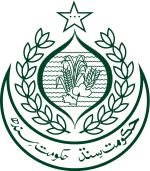Ror dynasty
The Ror dynasty (Sindhi: روهڙا راڄ) was a power from the Indian subcontinent that ruled modern-day Sindh and northwest India from 450 BC.[1] The Rors ruled from Rori Shankar (near present-day Rohri in Sukkur district of Sindh) and was built by Raja Dhaj in the 5th century BCE. Rori Shankar has been known by names such as Roruka and Rorik since antiquity. As capital of the Sauvira Kingdom, Roruka is mentioned as an important trading center in early Buddhist literature.[2] Buddhist Jataka stories talk about exchanges of gifts between King Rudrayan of Roruka and King Bimbisara of Magadha.[3] Divyavadana, the Buddhist chronicle has said that Roruka historically competed with Pataliputra in terms of political influence.[4]
Ror dynasty | |
|---|---|
| 450 BC–489 AD | |
| Capital | Rori (Rohri) |
| Religion | Buddhism Hinduism |
| Government | Absolute Monarchy |
| Maharaja | |
| Historical era | Iron Age India |
• Established | 450 BC |
• Disestablished | 489 AD |
Part of a series on the |
|---|
| History of Sindh |
 |
|
Ancient
|
|
Classical
|
|
Medieval
|
|
Colonial
|
|
Pakistan
|
| History of Pakistan |
Shortly after the reign of Rudrayan, in the times of his son Shikhandi, Roruka got wiped out in a major sand storm.[5] This event is recorded in both Buddhist (Bhallatiya Jataka) and Jain annals. It was then that the legendary Raja Dhaj (or Rai Diyach) built Rori Shankar in the year 450 BC.
See also
References
- http://www.historyfiles.co.uk/KingListsFarEast/IndiaSindh.htm
- Derryl N. MacLean (1989), Religion and Society in Arab Sind, p.63
- "Archived copy". Archived from the original on 3 June 2013. Retrieved 8 December 2015.CS1 maint: archived copy as title (link)
- "The Divyavadana (Tibetan version) reports: 'The Buddha is in Rajgriha. At this time there were two great cities in Jambudvipa: Pataliputra and Roruka. When Roruka rises, Pataliputra declines; when Pataliputra rises, Roruka declines.' Here was Roruka of Sindh competing with the capital of the Magadha empire." Chapter 'Sindhu is divine', The Sindh Story, by K. R. Malkani from Karachi, Publisher: Sindhi Academy (1997), ISBN 81-87096-01-2
- Page 174, Alexander's campaigns in Sind and Baluchistan and the siege of the Brahmin town of Harmatelia, Volume 3 of Orientalia Lovaniensia analecta, by Pierre Herman Leonard Eggermont, Peeters Publishers, 1975, ISBN 90-6186-037-7, ISBN 978-90-6186-037-2